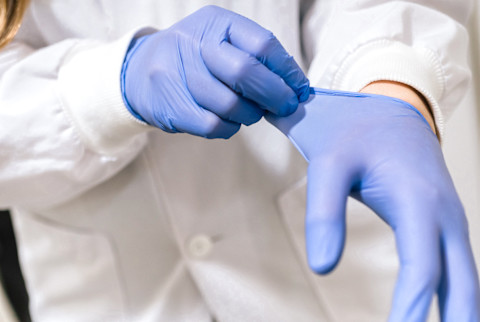How To Properly Use, Remove & Dispose Of Gloves During COVID-19

By this point in the COVID-19 pandemic, we're well aware of the importance of covering our noses and mouths with face masks (more on how to DIY your own mask here). But what about our hands? Well, the CDC hasn't rolled out a formal recommendation about wearing gloves in public as they have with face masks1, and best practices are changing by the day. While gloves are essential for medical professionals, there's some question as to how useful they are to the everyday person trying to avoid the virus.
Here's what we know so far about what gloves do, what they don't do, when they might be helpful, and how to make sure you're using them safely.
When should we be wearing gloves?
First and foremost, the CDC does currently recommend using gloves2 to clean and disinfect around your home, particularly if you're using harsh disinfectants like bleach. Linda Lybert, the executive director of the Healthcare Surfaces Institute, a nonprofit that works to mitigate the spread of infectious disease in hospitals, also recommends using gloves to open packaging that you're bringing into your home from outside, like that which holds groceries and takeout food, in order to mitigate the chance of exposure. (After all, though the virus is primarily spread from person to person, it seems to be able to live on surfaces for up to several days.)
As of right now, wearing gloves out of the house does not seem to provide any extra protection against the virus and may actually give people a false sense of security3. All in all, it's a waste of resources and you're better off sticking to other best practices like keeping an appropriate distance (6 feet or more) from others while in public.
How to put on and remove gloves properly.
Wearing gloves is not an excuse to get complacent about hand-washing. Always wash your hands thoroughly before applying gloves, and avoid touching the nose and mouth area when you have them on. It's also important to make sure your gloves fit properly: Too tight and they could tear; too loose and germs can sneak in.
Once you're done with your gloves, it's crucial to take them off properly to limit the possibility of any germs on your gloves coming in contact with your bare hands. Here's how to do it, plus a visual if you need it4:
- Grasp the outside of one glove at the wrist. Do not touch your bare skin.
- Peel the glove away from your body, pulling it inside out.
- Hold the glove you just removed in your gloved hand.
- Peel off the second glove by putting your fingers inside the glove at the top of your wrist.
- Turn the second glove inside out while pulling it away from your body, leaving the first glove inside the second.
- Dispose of the gloves safely.
You never want to wash or reuse disposable gloves, as it could weaken the material or cause tearing. Until someone thinks of a way to recycle latex gloves, it's better to throw them in the trash and grab a fresh pair when needed. After you toss your gloves, wash your hands again in the off the chance any germs got through them.
Are reusable gloves a safe option?
The CDC says that "heavier, reusable utility gloves" can be used at home, as long as you're washing them right away in a washing machine or a makeshift laundry setup. You'll want to remove them the same way you would disposable gloves, to stop any germs from coming in contact with your bare skin. Depending what kind of gloves you're using, follow the individual cleaning guidelines that come with them.
All in all, keeping your distance, using a face mask, not touching your face, and washing your hands frequently are the best ways to limit the risk of spreading or contracting coronavirus. If you are throwing gloves into the mix too, just be sure to be mindful about how you're using them.
4 Sources
- https://www.cdc.gov/coronavirus/2019-ncov/prevent-getting-sick/cloth-face-cover.html
- https://www.cdc.gov/coronavirus/2019-ncov/prevent-getting-sick/disinfecting-your-home.html
- https://www.who.int/gpsc/5may/Glove_Use_Information_Leaflet.pdf
- https://www.cdc.gov/vhf/ebola/pdf/poster-how-to-remove-gloves.pdf
